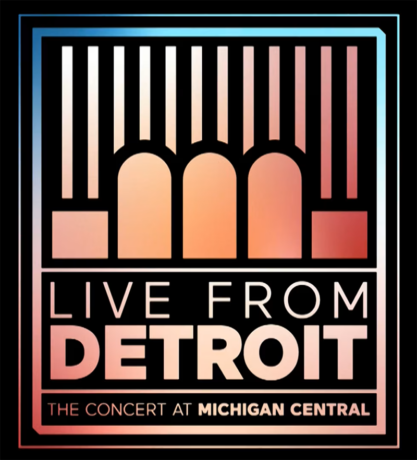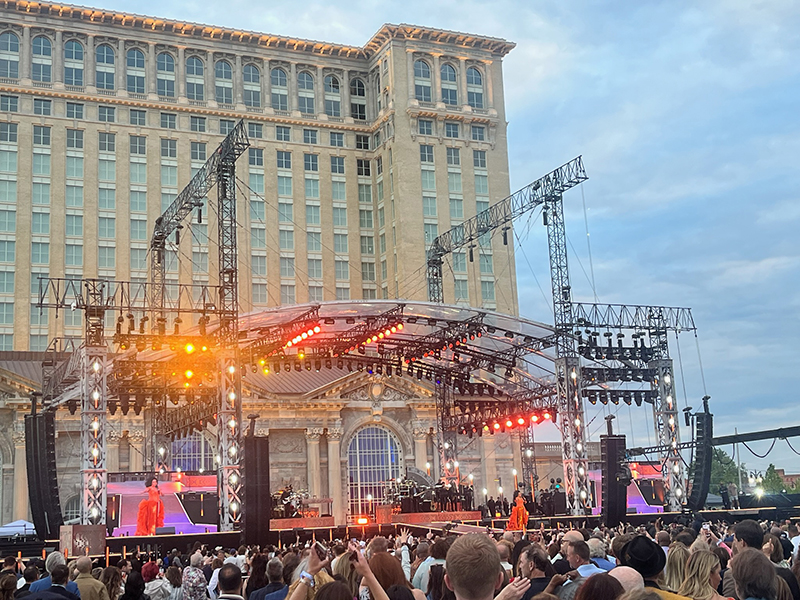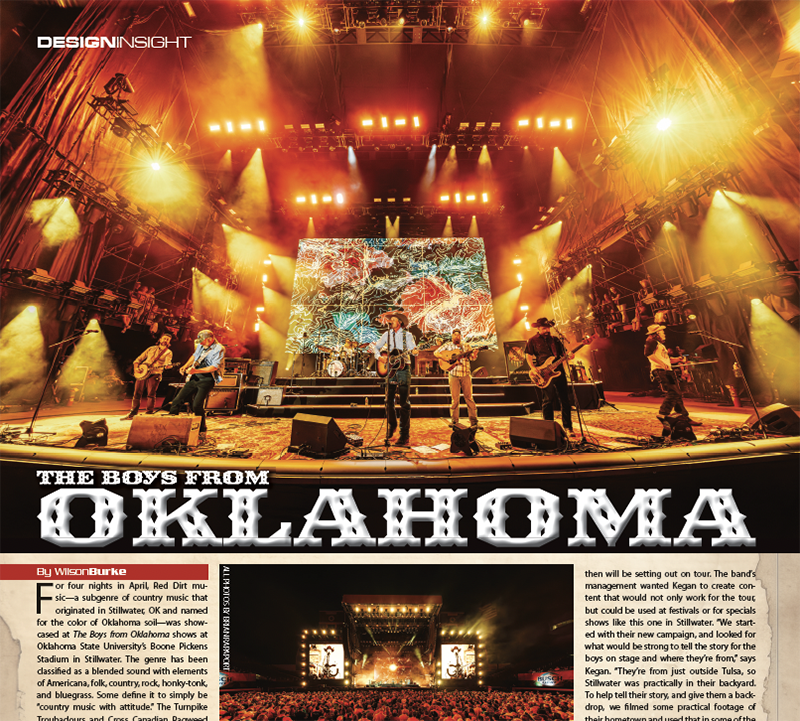
This June a celebratory concert showcased the city of Detroit, its music and the reinvention of its Michigan Central Station. Live from Detroit: The Concert at Michigan Central was also broadcast on Peacock live stream expanding the viewing audience and adding to the design consideration. Executive produced by Detroit native Eminem—who also performed—the concert featured a range of Detroit’s iconic musicians including Diana Ross, Jack White, Big Sean, and the Detroit Symphony Orchestra. The star and the backdrop for the evening was the once-abandoned Michigan Central train station that has now been re-envisioned by Ford Motor Company. After a six-year restoration the iconic building is a one-of-a-kind tech and culture hub. Production Designer Tamlyn Wright of Silent House and Lighting Designer Jon Kusner of 22 Degrees, working with agencies from Ford, Civic and Long Story Short, and live entertainment leaders Diversified Production Services and Jesse Collins Entertainment, led the creative team for this special musical event that welcomed 20,000 people to a downtown party.

TAMLYN WRIGHT, Production Designer:
Tell me about working on this concert.
It was really a fantastic project to be a part of. Detroit is an amazing city and this building is now one of its gems. During our meetings we kept saying that ‘the building is the client’; so what’s the design answer that’s right for our production?’ Do we want a big stage in front of this beautiful building? No, but a roof would be mandatory for the unpredictability of weather for a broadcast show. We didn’t want to block the views of the station; we wanted to feature it. We looked for the least obtrusive structure that complimented and framed up the face of the building, and Stageco really delivered.
Talk about your production design.
Diversified Production Services (DPS) brought me in to design this project, and I was tasked with creating drama around this architectural grand reopening, which is such a rare thing to be a part of. Plus, I am a rail fan and an architecture fan, so being part of something that had to do with this beautiful train station was special for me. It was amazing to understand how this revitalization was affecting the community and to hear their stories about this building. This new life for the building means a lot to them.
After our initial scout, I took some elements of the beautiful architecture to be used within the stage design. I took inspiration from the old steel-strapped columns of the station’s porte cochère. We all know what a standard Stageco structure looks like, but really it was about bringing the building’s architectural truss into the design as there was this beauty in the boldness of the construction of those trusses back in 1913. So, it was nice to bring something that speaks ‘train station’ to our American vernacular into the design. Rising from the stage is the technological part of the design in the band risers we had for Adam Blackstone and his band and for the Detroit Symphony Orchestra (DSO). The structures spoke to the future; to the rising of technology in that space again and the heartbeat of humanity being in that space once again. It had been a shell of a building for so long. So, it was an interesting take on the patterns that we used—speaking to the future and the past in the same gesture. The fascias of the band risers not only represented lit windows in the building, but also the 0’s and 1’s of computer language, as it is now a technology hub. Jon put lights under the decks behind the CNC fascias, backed with diffusion, which gave us the heartbeat that we were looking for and the look of a new techno city; a phoenix rising from its ashes, so to speak.
For the live broadcast element of the design, we had our needs for a live show logistics to consider. We needed a large space for the DSO, Jack White’s band, and for Eminem to come out at the end for his epic set. We had rappers and DJs that required less space, so we created the Disc Stage off house left. This way we could do a large reset on the main stage that would not be seen on camera, while featuring an artist on the Disc Stage. On house right we had a house DJ who played through the show. This area was also our backing for our presenters and dignitaries for the televised portions. It was a kinetic background and gave us more versatility for the broadcast.
Who were some of your vendors?
The structure, roof, delay towers and main stage were by Stageco, and the front of house stage extensions and decks for the various acts were from All Access. A newer vendor to the game is Edgelight out of Nashville, who make a fantastic rental LED linear product that was a gamechanger for us and our budget. The scenic company was Stage Works out of Fort Worth, TX. They took on the our new train station inspired stage surface, the architectural column reproductions, all the fascias, and the DJ stand. Zack Guthimiller, our site manager from DPS, facilitated with Stageco as we looked at early roof options. The thin bow roof, with it’s transparent skin, was just beautiful and framed up the face of the station, especially on camera. Anthony Bishop, the Art Director is always wonderful to work with across projects of scale and has a keen eye for elevating this from a festival-style show to a broadcast level production. Also, our internal team from Silent House Studios were great to work with, as always.
Talk about working with LD Jon Kusner.
We’ve been working together for over 25 years, so it’s a very comfortable working relationship, especially when it comes to discovering the priorities of the production for the camera and live audience. Working with Jon as he developed the lighting design, we wanted to highlight the vertical lines of the building, so, echoing those vertical lines in the lights were part of Jon’s world, which I thought looked beautiful. This was done by trimming of the edge of the stage; I wanted to make it feel like it was rising. Detroit has risen. It’s just such a vibrant place; it felt like the edges of the stage should be lifting up out of the ground to reflect that; giving loft to the excitement for the future in Detroit. Jon’s fixture choices really helped with that effect and gave it verticality, and the pulse we were looking for in daylight and dusk really shone in Eric Marchwinski’s programming.
Any final thoughts about this concert?
It was an honor to come in as an outsider to the city and really get to know, in a very short time, the history of the building and get to really have an appreciation for it. I wanted to have this be something special for everyone’s memories there in that community.
JON KUSNER, Lighting Designer:
Talk about lighting the stage and the station’s façade.
The building really was the star of this show, so no one wanted to put an over clunky, or visually impairing stage and roof in front of the building. To avoid that, the stage Tamlyn picked was a bit of a puzzle for the lighting team. When I started putting lights into the space, we quickly ran out of available weight load. With the nice, delicate curves, the clear span roof was great visually, but it didn’t hold as much weight as other options. So, we had to go through the whittling down process of what was needed and what the ceiling could hold. I think in the end it worked out well. Another issue is one that is always problem with doing outdoor shows, ‘how do you make front light positions?’ Here the Stageco towers for our lights and the PA were an excellent solution. You couldn’t ask for a better solution for outdoor shows, too many shows have terrible ideas about putting lights in scissor lifts. I was glad we avoided that.
What were some of your key gear choices?
Our front light workhorses were Vari-Lite VL3600s, which is a common reach for me. The followspots were long throw [Robe] BMFLs. Working with Tamlyn, we tried to come up with an identity that could be on—and around—the stage to help identify the performance space and we ended up going with a lot of [ACME] Pixel Line IPs, which is a new instrument. I’m fond of it because it’s affordable and well put together. It’s really a good visual tool that is responsive, which I think we took advantage of for this. I used Pixel Lines on the NFL Draft, also in Detroit, but they had a greater presence here for the concert. It was the most apparent visually present lighting gear, where you’re looking at the light itself. The rest of the gear was used more in a traditional sense, not as scenery. The Pixel Lines became a bit of the scenic story of the space. I also handled the lighting behind the perforated fascias of the risers. Behind the diffusion I used a lot of [Chroma-Q] Color Force IIs inside the risers.
Tell me a little more about lighting the Michigan Central Station.
The building has an impressive amount of LED lighting infrastructure [3,600 dynamic, color-changing fixtures] which is a base package of the building itself. That was all installed by Detroit-based Fantasee Integration led by Jon Weaver and Mike Peters. There are historic chandeliers in the lobby and the marquee in the front of the building that could be seen through the window on the performance stage. Every single bulb was an RGBW LED unit. My team interfaced with Fantasee so we could plug the station’s architectural control into our grandMA console and take advantage of all of it. The biggest workhorse we brought in for the building were P-10s from SGM, outdoor LED cannons. 4Wall worked hard to find a lot of them for us. I’ve used the P-10s now many times. It’s really a fantastic light. It all came together because it was a great paintbrush for filling in the building. All the architectural lighting became nice accents to give greater depth to the building. I was pleased with the overall look between the stage and through to the building.
What were some technical solutions you would call out that solved some challenges?
Organizing the interface to the building, which was all Eric Marchwinski of Earlybird Visual. Eric was programming for this and Earlybird did a previz file for us because we had no time. We used that as the starting anchor to get cues in the board, because we literally had two evenings to put this all together. We never rehearsed anything in darkness in the timeline of the show. So, the actual show itself was the first run-through that we had in real time.
The other challenge, being outside, the two days prior there were clear skies, or partial clouds, so we had a lot of direct sunlight at times through the magic hour. Then on show day, suddenly it was gray and dingy, and so it was significantly darker than we expected. We’d programmed with the idea that we’re in daylight, so we were heavier handed and then as the evening went on, we would throttle back to make exposure correct. Eric, who’s a hero—I don’t think there’s anyone better—was group mastering all the different areas of the building, the key light, and the sidelight, pulling it down to make exposure correct as we were driving through it for the first time, live on air.
How was the support of your vendor, 4Wall Entertainment, for this production?
4Wall was great. This project was handled by Bob Suchocki out of the NJ office as the Account Executive with Alex Flores as the 4Wall Project Lead onsite, and everything was easy. The Gaffing team was in the shop for four or five days. John Cox was the Gaffer, and working with Alex, put together a great group. It was all so well organized, which was important since time was short to load it all in. I have no complaints about how 4Wall handled a challenging load-in. We changed our minds up to the last minute, adding or subtracting as the needs became clearer with last minute talent additions, and they were nothing but gracious about adjusting and running with it. It was really a nice working relationship.
Any final thoughts about this project?
I want to mention Tyler Ericson, who was my Assistant and is another hero in the mix. Tyler is just a great person and I wish we could find more people with his energy and knowledge. Also, we had a second programmer—Jonathan Martin—who became important because Eric and I spent so much time just trying to get the creative elements of the show together. Jonathan got the system working and continued to hammer along with the crew while things were changing. During the show, he managed the followspots and the key light. While Eric dealt with the building lighting, Jonathan and I were talking about faces, intensities, and that kind of stuff.
And the building definitely deserves a nod. They brought it back from what was a desperate-looking situation to the grandeur that it was at one time, and it is again now. I give them all credit for that successful effort. From the building renovation to the concert itself, everyone can be proud.

VENDOR VIEW
4Wall
Bob Suchocki, VP of Live Events:
On the challenges 4Wall addressed
This show had a tight timeline for the build, challenging onsite restrictions, and a stage with a reduced rigging capability. Alex Flores (4Wall Director of Live Events) and RJ Thomas (4Wall Director of Live Events) did a great job ensuring the lighting and video packages were prepped to roll in onsite and deploy quickly and efficiently.
On supporting LD Jon Kusner and DPS
On an outdoor broadcast show of this scale, you are always up against last-minute changes and weather challenges. From the beginning, Jon and the 22 Degrees Inc. team had an excellent vision for the project and were very easy to work with. Their professionalism and expertise ensured everything ran smoothly, no matter the obstacles. And we are always excited to support our friends at Diversified Production Services (DPS). They pay attention to the smallest details and have a great team that helps to make the most challenging productions go smoothly. Also, anytime we can work alongside Firehouse Audio, C2W Rigging, All Access Staging, and Stageco, we know it’s going to be a great show.
On why 4Wall was the right vendor
Our vast inventory of IP65 fixtures, innovative networking solutions, and custom hardware helps us easily work through large outdoor broadcast productions. Pre-production time is always important on a show like this, and we tend to spend extra time during prep to make sure things are as plug-and-play as possible onsite.



